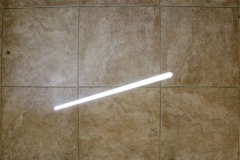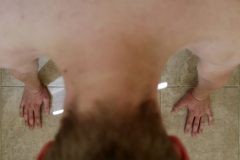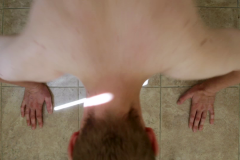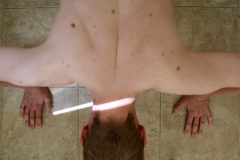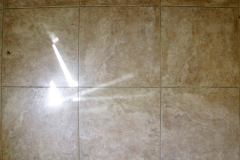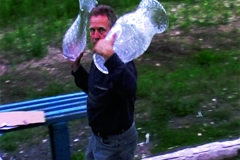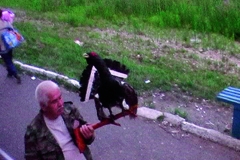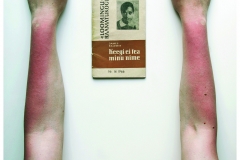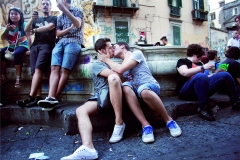Liina Siib (LS): Let’s talk about your personal exhibition Damage at the Contemporary Art Museum in Tallinn (3 Aug–8 Sept 2013, curators Anders Härm and Eugenio Viola), and about your residency and exhibition in Naples at Fondazione Morra Greco before that (17 Oct 2012–30 Jan 2013, curator Eugenio Viola). An observation, to start with: the aesthetic note, or your own aesthetics in your work, that strikes the viewer is perhaps a bit connected with fashion photography. After all, you are involved in this as well, so one enriches the other?
Mark Raidpere (MR): I agree, and this has been said before. When I started taking pictures, my first role models were in fashion photography, which is characterised by extreme perfection, being composed to the last millimetre. I set out to achieve the same effect. Commissioned work, the glittering world, is considerably more extensive than my work as an artist. However, I am always as fastidious about this work, even if it is not quite as significant as my gallery work. My artwork is the best part of me; there is nothing much going on in my existence anyway. I do not, on the whole, cope that well in most spheres of practical life, but for some reason when I, a relatively non-productive author, offer something to the art world or stick my nose into it, the results are mostly above average.
LS: The urban space photographic series for your earliest work at the Contemporary Art Museum exhibition, A User’s Guide to Tallinn in 2001, was supported by Napoli 2012. Did you think about the Tallinn pictures in Naples?
MR: No, not really. Only when we began compiling the Tallinn exhibition. I was quietly pondering the Tallinn work, but when Anders Härm suggested it would be interesting to display them, I of course agreed at once. Both series are quite exceptional among my work, as they are the only 2 series of cityscapes I have executed. I was most of all keen to see whether and what they had in common.
LS: Despite the 10-year gap between photographing Tallinn and Naples, a strong link emerges. The Naples work addresses the Tallinn work and provides it with a new layer of meaning. I now look at them both from a kind of theatrical perspective. Here is your mise-en-scène, how you see things and photograph them.
In the Naples work, you are closer to people. People in the Naples pictures seem to respond to your glance, as if some communication has been created.
MR: Tallinn was restricted to fewer sessions. I had a list of specific areas in the city, as it was a commissioned work. I photographed the architectural environment and the general appearance. In Naples I was free and thus paid more attention to visual scenes and character; the focus was different.
LS: As you photographed people in Naples and Tallinn in a well-composed key, these pictures could perhaps also be seen as fashion photographs, especially the ones of Naples, with the torn jeans, à la Italian Vogue, Diesel or Calvin Klein. If we take pictures of more marginal people, people in the street, types in the usual documentary photo regime, nobody wants to look at them for long; they do not really matter to anyone, but a touch of fashion photography adds a certain component of desire to them.
MR: I try to introduce a very simple thing into my pictures: beauty. That’s all.
LS: What was your sense of distance in Tallinn and in Naples? Is it easier to photograph in an environment where you do not know the unwritten rules, i.e in a strange place?
MR: In Naples, the camera helped me to get in touch with the city and relate to an environment where nobody speaks English, where people are so different, where you feel anxiety at each step because you do not know the system. Besides, Naples is a dangerous city. My camera provided me with a role there. It is of course easier to be so-called certifiable in a strange place, because you are not supposed to know anything, but I still had to decide how I was going to operate the camera there. I had to think all the time about whether this was the place to raise the camera, whether I should be unnoticed or whether I should be visible, whether I should establish contact or make do without it. I had to be alert at all times about what kind of regime I would ignite in myself. I lived in Centro Storico, and the whole first-floor theatrical essence was there: a maze of streets, like a village, simple merry people, permeated in bad deeds, camorra dictate… There were things that got on my nerves, but I put up with them, and eventually the town put up with me. Naples is a witch-town, as Aare Pilv wrote (in Ramadan, 2010). Naples draws you back, it is unique and fascinating, and it does not let you go, a sinner of a city.
LS: Do you have a special regime, with a street as a place for taking pictures? Or is it just a place like all the rest?
MR: It is just a place, not a genre. The photographs of these two towns are a major exception in my work. There are indeed artists whose fields of action and themes hardly change. I am hopelessly eclectic. Nobody can claim that I rely on street photography or work exclusively in the studio. Nothing is further from the truth. A certain urban element is probably prevalent in my work, and I cannot imagine myself doing something outside urban environments.
LS: What about Vekovka?
MR: That was on a train. Besides, it is just a small town on the way from Moscow to Izhevsk, as well.
LS: Vekovka is a visually rich film, with several lines running through it.
MR: It has been shown in Tallinn once, at the Finno-Ugric exhibition at Kumu, curated by Anders Kreuger (North and Northeast: Continental Subconscious; Kumu Art Museum, 2008). A friend of mine who went to the opening joked about it: “Mark, I have a feeling that you have reached a Chekhovian period in your work”, referring to a change in tone or emotion as compared with my earlier things. This work is more poetic and acquiescent.
LS: Did the sound ignite the visual line?
MR: This was an expedition (Mark, Hanno Soans and Juku-Kalle Raid); when we visited Udmurtia, the Mari El Republic, we also travelled through Kazan. That could have been the second day on the train. The three of us sat in the restaurant carriage in the evening. I had already heard of the custom of people at Russian whistle stops trying to sell all manner of absurd things. Juku had invited a Russian to our table, we had some vodka, the train stopped, and I looked out of the window: the first person to pass by was a man carrying a stuffed bird on a long stick over his shoulder. In the midst of the idle talk in the restaurant, I thought that when strange circumstances coincided you could indeed glimpse something as weird as that. However, after a momentary pause, more weird passers-by appeared on the scene, and I understood that this was the custom: people sell everything, from eggs to mothers trying to sell their daughters. As I had my camera ready, I went to the outside area between two carriages, hoping it would be nice and quiet to film there. As it happened, Juku-Kalle and our Russian companion came there too after a while for a smoke and a chat. The text in the video is the real chat they had while I filmed. I knew how crucial that moment was. All the components were suddenly there together. It was in 2007, after the Bronze Night, and everything was very topical for me: the national issue, the Soviet era (the Russian had been to Tallinn and remembered specific motifs and places) and the language issue. The whole array of themes opened up spontaneously, through the dialogue between an inebriated Estonian and an equally boozy Russian.
LS: Is the element of staging, setting the scene, important in your work?
MR: I never stage anything. They are minimally staged.
LS: But what about your run in Pae St. Playlist?
MR: I prepare some sort of structural thing in my head. In Pae St. Playlist, the pictorial concept was of course previously devised. Also, in Shifting Focus, I established some vague frames of action and location, but that was all. There was no script. All of my videos are of a documentary nature. Thinking of the sound in Pae Street, I planned to have a chat with just my mother, as my father was in bad shape. Besides, with my mother I hoped to tackle an aspect or two which would be impossible with my father, because he might have thought them too uncomfortable. On the day of our conversation, I travelled to the Lasnamäe residential district, after a long gap, and decided to have a coffee on a café terrace near my mother’s home. All of a sudden, I saw my father, right there, walking towards the bank, leaning on his cane. I instinctively ducked down, hiding behind the terrace railing: I didn’t want my father to see me; it was against my plans. But then I somehow felt in my bones that it was wrong to ignore him: seeing him was like a sign. This is an excellent example of how chance, even mishaps during shooting, are always welcome to me. With good judgement and skill, they provide extra meanings and can lead you where you would not have known to go. Unexpected things are usually enriching.
LS: The Pae Street work makes you think about the selective character of memory.
MR: I wanted to gather key memories together. Tales told by my parents, which might differ from my own memories. It also turned out that my father remembered some things differently than my mother. For example, describing coming home from the maternity hospital. Father says: “…although it was a sunny day”, whereas mother claims: “And the day was overcast.”
LS: Pae Street could be anywhere. It is a personal work which tells of personal things, with generalisation, in a specific place without the restrictive aspect of locality.
MR: I guessed already at the early stages of the work that the grey blocks of flats in Pae Street were in fact an asset. Had the place had a specific character, it would have been less effective.
LS: You thus consider the viewer.
MR: Yes, the viewer is very important to Raidpere. I’d rather not offer people any intellectual puzzles, but instead I’d like the viewer to feel emotions. For me, a 100% success is when the viewer leaves the exhibition in a heightened mood. The viewer should be emotionally involved. The work about my father’s sms-s (Video 09/12/07 – 05/04/09) might be difficult and bleak, but many have said that they left feeling elevated.
LS: Your series of self-portraits Damage seems like writing with your body on a marble floor, although these are photographs. This physical aspect creates an association with Catholic art, for example the picture where you have a sunburn. A tortured body, broken sunglasses, isolation, à la a saint in a desert. The body, the body’s reactions to climate, a marble floor, Italy, sport and James Baldwin would be some keywords.
MR: It is easy to start with keywords. Isolation: bull’s eye! I would replace torture with compulsion. The sunburn photo Nobody Knows My Name was the first picture I completed in this series. It is a reflection of my arrival under the Naples sky, hanging around in my two-storey six-room apartment with a roof terrace, without having a clue what was going to happen next. I was an alien in that city, a stranger and isolated. Due to the famous Giovanni’s Room, James Baldwin has been essential to me for decades. But how could the famous gay writer suddenly get published in the Soviet era? Because the collection Nobody Knows My Name (Loomingu Raamatukogu 1968) consists of essays about American racial discrimination, written in his beautiful poetic language; it is a text of its era. This slim volume has for many years accompanied me on my brief artistic excursions, but I had never actually read it through. In every new destination, I prefer to perceive the place and not stick my nose into texts. Now, in Naples, I finally read the entire book. The book is crucial in my own biography. A companion. The pictures in the series Damage are associative, describing my general inner mood upon arriving in Naples and living there.
LS: I also find humour in the series.
MR: Oh yes. Certainly.
LS: A black author and a sunburnt author, a cactus, a desert, a hermit Hieronymus and a lion. A man in a cupboard.
MR: I’d use the words tragi-comical, self-ironic. The apartment in Naples was enormous. In the second week, I still got lost in those six rooms. The place was huge and very photogenic, ascetic and uniform. An excellent background system for such small games. Each room had a different stone parquet floor. The short video Workout in Progress (2012) emerged from my plan to reignite my training programme in Naples. I remained faithful to the plan and filmed myself every day on a different parquet floor doing push-ups. I wanted to create a diary-type recording of a routine compulsion. In the end, I chose only the recording of one day, a long unique shot that followed the movement of the sun between the window shutters. I had been invited to Naples in two previous years, but for various reasons had been unable to go. Then I had some time and as I hadn’t done much as an artist for several years, I decided to put myself in that kind of situation. It was a voluntary compulsion.
LS: Did the title of the exhibition and series, Damage, come from Naples?
MR: The Naples exhibition was called Napoli.ok, and it displayed Damage, Naples 2012, Workout in Progress, 09/12/07 – 05/04/09 and the space installation A Bench of. In a reduced form, the exhibition travelled to Paris, titled I´ll Come Back Later (Galerie Michel Rein, 2–30 Feb 2013).
I saw Louis Malle’s film Damage in 1992 on Finnish television and its finale stuck in my mind. I suddenly remembered it last year and I watched it on Youtube to check my memory. The epilogue has actually nothing much to do with what comes before in the film, either stylistically or emotionally. At the end of the film, in its strong eighties’ sauce, the epilogue seemed timeless. I probably remembered the segment because of my inner perception in spring 2012, a perception that I was standing back-to-back with the world. I went to Naples with this epilogue, pulled myself together there and forgot the film. Until the last moment, the self-portrait series had no name, although each photograph did. We were setting it up in Naples and suddenly a mishap occurred. The work was printed in Tallinn and put on aluminium plates, but they were badly packed and arrived in Naples damaged. Everything was bent at the edges. We discovered this just a few days before the opening and of course there was no time to do them again. However, I was determined that the pictures should be displayed. Luckily, a technician at the Fondazione managed to sort them out pretty efficiently. On the evening before the opening, I suddenly remembered how it, after all, had started with the film Damage, and that’s how the series got its name. In Tallinn, the co-curator Anders Härm wanted the exhibition at the Contemporary Art Museum in Tallinn to be called Damage. It covered the exhibition nicely. I was pleased with my display, and nothing seemed out of place. I am extremely grateful to the museum. I haven’t exhibited much in Estonia. I am not a productive artist, and for me art is a traumatic activity, but that’s inevitable. The audience should not be traumatised; the journey for viewers must be more refined. However, my works of art are not born out of happiness and joy.
Mark Raidpere (1975), photo and video artist, represented Estonia at the Venice Art biennale in 2005, has received Hansabank Group annual art award (2005) and Ars Fennica Award (2008).


